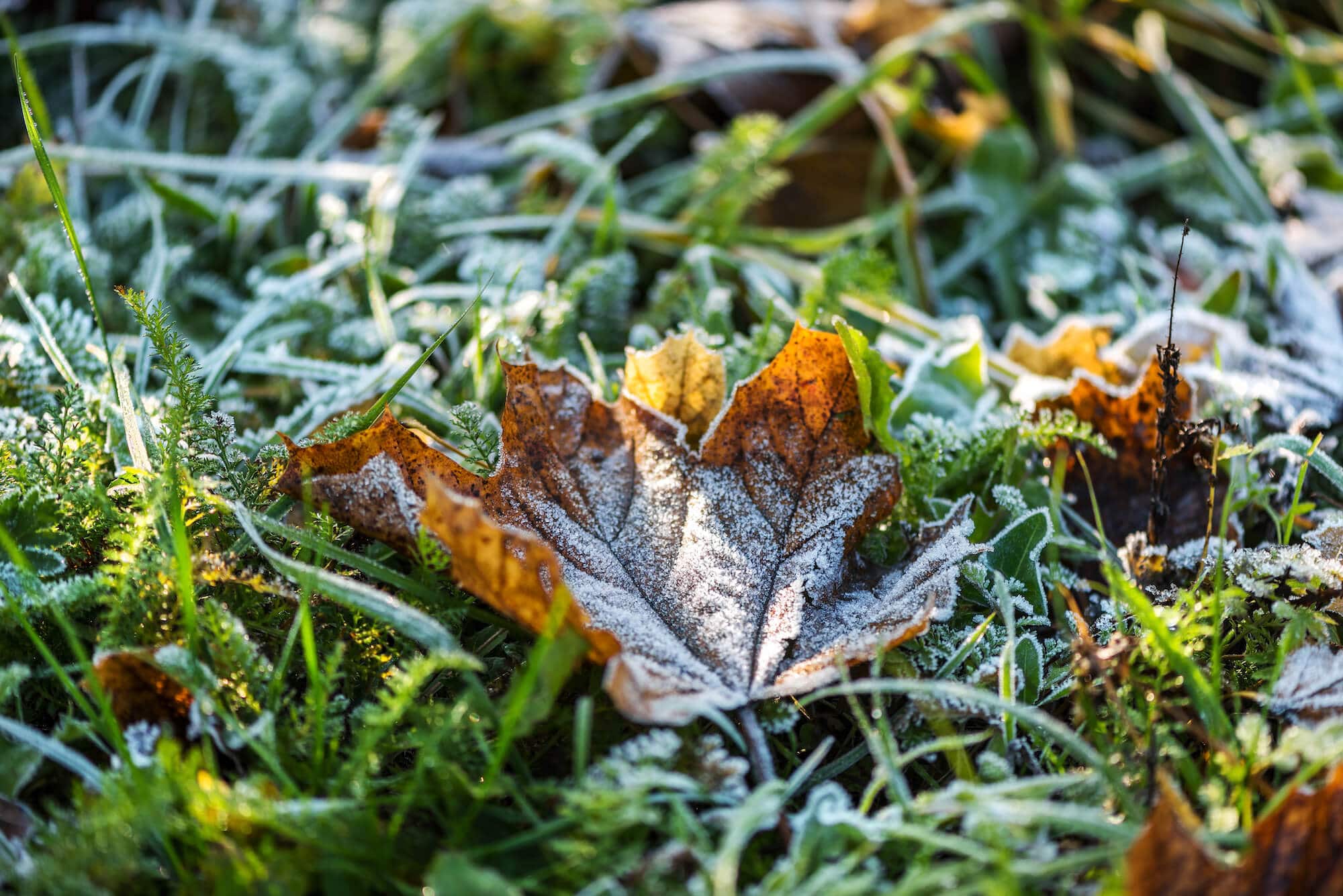Winter Lawn Care: Caring for Dormant Grass
After providing nearly nine months of TLC to your lawn, the winter is a time to take a rest and ensure your grass stays fed and protected throughout the winter. While winter lawn care is minimal compared to spring, summer, and fall, there are several important things to note about what happens to your grass during these months and now to ensure a healthy year ahead.
In this guide, we’ll walk you through how to care for your lawn going into the winter, during the peak of the season, and when spring appears on the horizon in March. Winter may look different across the country, but your soil and the grass will hit their low—or dormant—growing season as the temperatures drop.

Warm-Season vs. Cool-Season Grasses
We tend to associate winter lawn care with the colder states where the soil freezes and the grass goes dormant for nearly three months. It’s important to note that not all lawns behave in the same way throughout the winter. In the deep south and tropical climates, for example, warm-season grasses can stay lush and green if the temperature remains steady.
Warm-season grass growers in these much hotter climates can follow many of the fall lawn care tips throughout the cooler months as well, including pulling weeds, overseeding with other warm-season grasses, and keeping an eye on thatch and compacted soil. You can even keep watering these lawns up to an inch a week.
However, most warm-season grasses go dormant in the winter, if not as early as the late fall. They are especially since they are less protected against a sudden drop in temperatures. Instructions for these warm-season grasses as well as cool-season and transitional zone lawns, differ significantly from the fall, summer, and spring months.
Preparing for Dormancy
It’s easy to fear that your grass will simply die out in the extreme conditions of the winter. If you have the right variety of grass in your region, however, the grass is prepared to protect itself from the down season just like many of your trees and shrubs.
A grass goes dormant when temperature or moisture level drops below a certain level for an extended period of time. Dormancy allows the plant to cut down on energy use and save it up for next spring. Dormant grass will no longer hold that rich green color as it did in the summer. Yellow and brown blades will intersperse between the green.
If your grass turns completely brown in the winter and has trouble coming back in the spring, speak with a landscape professional at TruGreen to determine if you have the wrong variety for your region.
Early Winter Lawn Care
Lawn care during this tricky transitional time has a lot to do with when the first frost arrives. In some areas, especially climates in the transitional hardiness zone, this may not arrive until early December.
In other words, many of the late-fall lawn care tips may spill over into the early winter, especially if you didn’t have time to take care of them sooner. Use these first few weeks of winter to finish up a few tasks that support and feed grass before it enters the coldest months.
1. Fertilize One Last Time
One of the trickiest decisions for a homeowner is determining when to apply your final layer of fertilizer. Ideally, this comes before your grass has gone dormant—before the first frost—and after your final mow of the season.
This time of year typically calls for fertilizers high in nitrogen so the grass can store this energy throughout the winter. However, stick with fertilizer blends that are specific to your climate and variety of grass. Many winter-ready blends will be called “winterizing fertilizers,” denoting that they are ideal for the last layer of the season.
It’s important to note that some areas put restrictions on the dates you are allowed to spread fertilizer on your lawn. Some states will place a blackout period for fertilization during certain dates, so be sure to check local laws before applying.
2. Shift Your Mowing Schedule
By the time late fall rolls around, you’ve likely already lowered your mowing blades to keep your grass short for the winter. Be sure to still leave about two inches to allow your grass to root into the early with stability, but there’s no need to let it flourish as you did in the summer.
Keep an eye on when your grass stops growing for the season. This may be difficult to spot, since a random frost or coating of snow may not cause it to stop growing altogether. Once it has halted for the year, though, it’s safe to put your mower away.
3. Cut Down on Watering
In the north, it isn’t necessary to water your lawn as frequently throughout the colder months, especially during a rainy fall and into a snowy winter. If you experienced extreme drought in the fall, cut your watering schedule down to apply half an inch of water once every two weeks—instead of an inch each week.
Before watering your lawn, run a rake loosely over the soil to break open the compacted earth and welcome more water to its roots.
If you haven’t done so already, close up your sprinkler system for the winter after draining its hoses and pipes. Unless there is a significant drop in precipitation for weeks at a time, your hose won’t be needed until next March.
Mid-Winter Lawn Care
Once your grass fully drifts into dormancy—it will be clear when it stops growing and loses its color—you can give your lawn some space to rest for most of the winter. The majority of grasses handle cold weather cleverly enough to reserve energy for the next warm season, so it’s important to let it do its thing in the meantime.
Still, there are a few mid-winter tips to know to keep it healthy, especially during times of heavy snowfall.
1. Cut Down on Foot Traffic
Even though your grass is strong enough to make it through the winter freeze, it’s best to give it space to thrive without much disruption. Cut down on your lawn’s pressure in the winter by avoiding walking on it wherever possible.
It’s also important to avoid placing heavy equipment or storage on areas of your lawn during this time. Compacted soil will make it more difficult for grassroots to spread out in the spring when the ground begins to thaw.
2. Be Careful with De-Icers
Sidewalk salt and other de-icing chemicals can be particularly damaging to your lawn, even when it’s covered in a thick layer of snow.
Problems typically occur when salt is spread across your steps and walkways and then washes onto your grass. While this can’t be avoided in some circumstances, try to avoid spreading the salt too close to the end of the cement to avoid turf damage.
Luckily, grass will typically bounce back from salt damage in the early spring, but you may have several weeks of yellow or brown spots around its edges.
3. Keep Up With Debris
There may no longer be any leaves on the trees, but debris from branches and snow are common throughout the winter, especially as snowdrifts start to melt. After each defrost, clean up your lawn to protect your turf from displaced stones, heavy branches, or any other thick layers of material that can keep sunlight from reaching the soil.
Late Winter Lawn Care
If you’re excited to jump into next year’s lawn care plan, now is the time to build a strategy and make sure you’re ready for the spring. Depending on your region, late winter can bring warm enough temperatures to break out the hose, aerator, and even mower in the right conditions.
1. Schedule Your Lawn Care Plan
This respite of downtime is a great opportunity to look back and see where your lawn struggled over the past year. Did you spend a lot of time fighting off lawn fungus? Did you have to treat your lawn for weeds and pests? Going into the next year with a better fertilizer, seed blend, and even lawn tools can make your upcoming season a lot easier.
Speak with your local TruGreen team about easy tests to schedule in the earlier spring, including:
- A pH soil and nutrient test
- Choosing fertilizer for your grass variety
- Aeration and dethatching tools
- Pre-emergent weed control
- Common signs of pests in your lawn
Organize a calendar for the upcoming months with our year-round lawn care plan to always stay ahead of the game as the season speeds up.
2. Clear Away the Final Snow Piles
Ice and snow have the habit of building up in these later months of winter and sticking around in specific areas of your lawn. Break up these patches of thick snow and ice and spread them more evenly around the lawn to help them melt more quickly and evenly.
This process protects the grass underneath these heavier piles of snow both from compaction and from the threat of fungus once the weather suddenly warms up.
3. Avoid Moving Too Quickly
When the final weeks of winter finally arrive and your grass is finally clear of snow, it could be tempting to jump into initial lawn care to prepare for the spring. However, it’s important to give your grass some time to breathe and complete its dormancy period to avoid pushing it too quickly.
Your grass will likely look like it needs immediate intervention by this point, but it is simply storing its final bits of nutrients before waking up as the soil thaws. Avoid raking or aerating your lawn until the highly damp period of late winter passes and allows the soil to fully thaw and dry.
In most cases, avoid mowing, fertilizing, or overseeding your lawn until spring, preferably at least two weeks after the last frost.
4. Prep Your Tools
Signs of warmer weather ahead signal an excellent time to break out your spring lawn care tools and ensure they’re ready for one of the busiest times of the season. For example, take your mower to your local landscape specialist for a blade sharpening, refueling, and an all-around tune-up.
Break out your hand tools from the shed and ensure that they didn’t become blunted or rusty over the winter as well. This is also a great time to check if there are any additional tools that will simplify your life in the coming year.
Winter Lawn Care from the Experts
Unlike other seasons, winter care is primarily focused on taking preventive measures to protect grass in its dormant phase. However, keeping a professional team on hand—especially one familiar with your unique local climate—can simplify your winter things-to-do list.
TruGreen offers an extensive list of lawn care and maintenance plans for everything from seasonal rejuvenation to landscape troubleshooting. With locations spread across the US, our expert and environmentally focused services are some of the most highly trusted in the nation.
In addition to lawn care, the TruGreen team can advise how to care for all your winter-sensitive trees and plantings. Without the worry of keeping your lawn safe in the winter, you focus on getting the rest and relaxation after a long year of dedicated lawn work.







